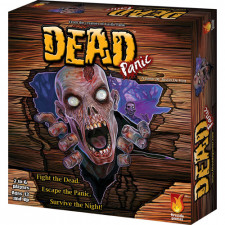Dead Panic Review
on Aug 26, 2015
Boy, would I love to have been a plague fly on the wall for this game's genesis. Fireside Games, having experienced breakout success with their cooperative tower defense game Castle Panic, widely considered one of the most accessible co-ops on the market, decided to take the IP in a new thematic direction, maybe expand the audience. And in 2013, no theme guaranteed a larger, more devoted audience than zombies. Never mind that Castle Panic's popularity rested partly on its family-friendly cartoonishness; as Kickstarter has taught us, the zombie craze will never die.
On the one hand, the idea is dead obvious, at least in hindsight. Castle Panic's core concept saw monsters appearing at the edges of the board and advancing slowly inward, through a series of concentric rings, toward the castle at its center. If the bad guys reached the castle walls, they would damage them, eventually causing the defenses to crumble and revealing the precious towers hidden within. This idea of a relentless stream of enemies converging on a central location and slowly wearing down its defenses is practically begging for a zombie makeover. At the same time, Castle Panic's innovative component design—the triangular enemy tokens rotate clockwise each time they're hit, with the center-facing corner displaying their remaining HP—is equally suited to these notoriously hard-to-kill undead.
However, somewhere in its development, Dead Panic lost its identity as an embellished retheming of Castle Panic, and that's where I imagine the problems started. For instance, somebody had the bright idea to have the players representing by individual survivors who move around the board swinging crowbars and taking hits. It's a great idea in theory, addressing the common complaint that its predecessor felt too much like a 1-player game awkwardly shared by a larger group.
But in practice, putting the players on the board decays the same core gameplay concepts that made the theme so perfect in the first place. Because players can leave the central structure (this time, a cabin in the woods) and battle zombies in the outer rings, that inexorable advance toward the center stopped being relevant most of the time: the game now has rules for line of sight and target priority, rules that see the zombies moving sideways and backwards just as ofter as they shamble forwards, all of which plays out very awkwardly on the board's arc-and-sector design.
Then there's the cabin itself. Since the characters spend much of their time outside it, and the ultimate goal of the game has nothing to do with it, there's not really a point in keeping the cabin's walls erect. You can repair cracks in the walls, but why bother when it's nothing more than a convenient place to restock your arsenal? And again, since it's not really a tower defense game anymore, why does the map still look like a dartboard?
Even though Fireside seems to have lost the plot when tying it back to the original, Dead Panic ends up being a surprisingly good zombie game on its own merits. It's clearly aimed at an older demographic than its precursor; the white-eyed, decaying zombie on the cover is a dead giveaway, and the artwork inside the box is even more gruesome. (But why are all the zombie tokens pink?)
However, despite a horrid rulebook that contradicts itself and neglects to mention several crucial gameplay elements, Dead Panic retains a lot of its precursor's accessibility. The enemy triangles are still a great way of seamlessly tracking damage, though it no longer makes as much sense that they're always pointing center-wise. The combat is equally simple, resolved by a single roll of 2 dice. This lets you turn your brain off for the majority of the experience, something that, in my opinion, the zombie genre demands. Even then, it's got several layers more strategy than Castle Panic.
It's got everything you'd expect in a zombie game—limited ammo, scrounging for supplies, fending off the horde, and survivors from all walks of life—and most of it works surprisingly well. I recommend using all of the rulebook's optional variants, which add some more variety and theme, things like allowing rifle-users to aim for headshots or giving players 1 round to shoot KO'd allies before they get zombified.
It also manages to incorporate the semi-cooperative, out-for-yourself mentality endemic to zombie narrative. There's a "Bait" token that determines the first player...but it also breaks ties when zombies get to choose between equally distant targets. The basic rules have this rotate to the left, but a variant allows you to choose who gets the Bait next, which might mean the difference between your life and theirs. Of course, if somebody does throw you under the bus, there's another variant to allow dead players to return as semi-intelligent zombies and seek revenge.
The one concept that doesn't really work is, unfortunately, the main goal. The idea is that survivors will randomly appear from the woods and make a run for the safety of the cabin. If they make it inside, they'll give you a radio fragment; combine all 3 parts together and you can call for evac. But since survivors appear in the thick of the horde and are target numero uno, they seldom make it inside. Nor is there much incentive to protect them, since killed survivors will just drop their radio part where they fell.
This leads to the game's final failing: it's just a little too easy, even with the semi-cooperative rules turned on. Nevertheless, as I always say, there's no co-op game that can't be house ruled into the perfect challenge level. In the end, Dead Panic is a great choice for a low-complexity zombie title, way better than the classic Zombies!!! It's a shame so few gamers seem to have received the transmission.

 Customer Support
Customer Support  Subscribe
Subscribe 




 Account
Account  Wishlist
Wishlist 

